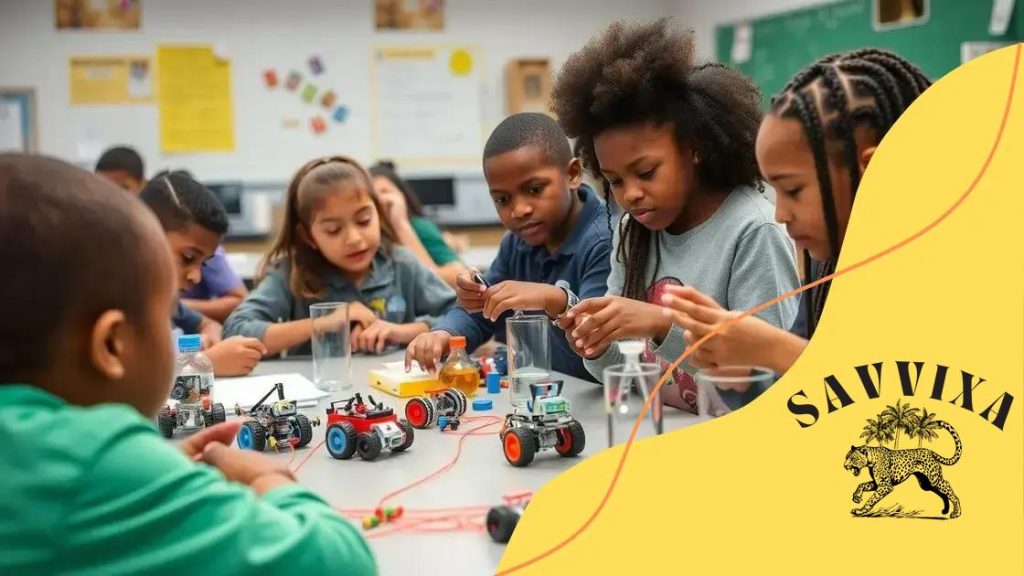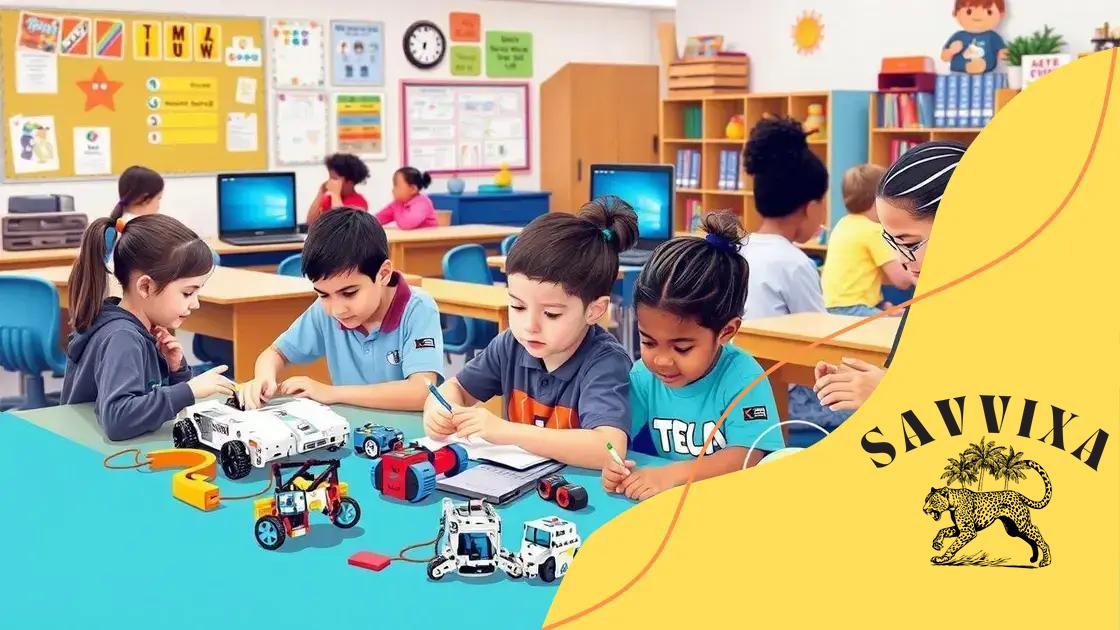STEM education innovations transforming the classroom

STEM education innovations enhance learning by integrating technology, fostering interdisciplinary approaches, and developing essential skills to prepare students for future challenges in science, technology, engineering, and mathematics.
STEM education innovations are changing the way we teach and learn, making classrooms more engaging and effective. Have you ever wondered how these new approaches can benefit students and prepare them for the future? Let’s dive in!
What are STEM education innovations?
STEM education innovations are new methods, tools, and approaches designed to make learning in science, technology, engineering, and mathematics more engaging and effective. These innovations aim to spark student interest and prepare them for the challenges of the future.
Types of STEM Education Innovations
Many schools are adopting innovative practices in their STEM programs. This is not just about using new technology but also includes new teaching methods that inspire creativity and critical thinking.
- Project-based learning allows students to work on real-world problems.
- Flipped classrooms enable students to learn at their own pace using videos and interactive tools.
- Hands-on experiments help students grasp complex concepts effectively.
- Collaboration with local businesses gives students exposure to careers in STEM fields.
These practices not only enhance comprehension but also build essential skills. For example, project-based learning encourages teamwork and problem-solving. As students engage in projects, they learn to communicate effectively and think creatively.
Furthermore, incorporating technology in these innovations is vital. Tools like coding platforms and robotics kits make learning interactive and fun. By merging traditional teaching with innovative techniques, educators can keep students interested in STEM disciplines.
Overall, STEM education innovations are about creating a dynamic learning environment. When students are involved and invested in their learning, they are more likely to succeed and build a passion for these critical fields.
Benefits of integrating STEM in classrooms
Integrating STEM in classrooms brings many advantages that enhance learning and help students prepare for future challenges. By focusing on science, technology, engineering, and mathematics, teachers can develop more engaging lessons.
Enhanced Problem-Solving Skills
One significant benefit of STEM is the improvement of problem-solving skills. Students learn to tackle complex issues through critical thinking and creativity. This approach encourages them not just to find answers, but to understand the processes behind solutions.
- Encouragement of critical thinking.
- Development of analytical skills.
- Ability to approach problems from various angles.
- Fostering a growth mindset.
Another key aspect is preparing students for future careers. With technology rapidly changing, having a strong foundation in STEM subjects opens doors to numerous job opportunities. Many careers today require knowledge of science and technology.
Improved Engagement and Motivation
Integrating STEM can also lead to increased student engagement. When students see the real-world applications of what they are learning, they become more interested and motivated. For example, hands-on projects make learning fun and relatable.
Additionally, collaboration is a natural part of STEM education. Group projects encourage teamwork, communication, and leadership skills. In a team setting, students share ideas and learn from one another, enriching the overall educational experience.
Furthermore, with STEM integration, students gain confidence as they overcome challenges. This confidence transfers to other areas of their educational journey, making them more resilient learners. Overall, the benefits of integrating STEM in classrooms create a positive learning environment that fosters growth and innovation.
Examples of innovative STEM programs

There are numerous exciting examples of innovative STEM programs that are transforming education today. These programs incorporate modern teaching methods and technology to engage students in meaningful ways.
Project-Based Learning Programs
One popular approach is project-based learning. In these programs, students work on real-world challenges that require them to apply their knowledge. For instance, a program might involve designing a sustainable garden within the school.
- Students research plant biology and environmental science.
- They apply math skills to plan the layout of the garden.
- Hands-on activities allow students to learn by doing.
This method not only reinforces classroom concepts but also fosters teamwork and communication among students.
Robotics and Coding Initiatives
Another example includes robotics and coding initiatives. Schools are increasingly offering clubs or classes where students learn how to build and program robots. These programs often lead to exciting competitions where students showcase their creations.
Through this experience, students gain critical skills in technology and engineering. They become familiar with coding languages and problem-solving techniques, preparing them for future careers in tech sectors.
STEM Camps and Workshops
STEM camps and workshops are also effective in promoting innovation. During these immersive experiences, participants engage in various activities such as building drones, programming apps, and conducting experiments. For example, a summer camp might focus on environmental science and involve field trips to local nature reserves.
These hands-on experiences are vital for sparking curiosity and passion for learning. Students leave these programs excited about their future opportunities.
By incorporating these innovative STEM programs, educators can cultivate a generation of problem solvers, critical thinkers, and innovative leaders.
Challenges in implementing STEM education
Implementing STEM education presents several challenges that educators must address to create effective learning environments. These hurdles can affect the successful integration of STEM principles into the classroom.
Limited Funding and Resources
One significant challenge is securing adequate funding and resources. Many schools struggle to provide the necessary tools for a robust STEM program. This includes access to technology, lab equipment, and educational materials.
- Budget constraints can limit the purchase of resources.
- Schools may lack modern technology like computers and software.
- Inadequate lab facilities hinder hands-on experiments.
- Professional development for teachers might be underfunded.
Without proper resources, teachers may find it difficult to implement engaging projects that promote inquiry and creativity.
Teacher Training and Support
Another challenge lies in the need for effective teacher training. Educators often require support to develop their STEM teaching skills. Many teachers may not feel confident in teaching STEM subjects due to a lack of training.
Providing ongoing professional development can help teachers gain the skills they need. Support networks are essential for sharing resources and strategies. When teachers collaborate, they learn best practices that enhance their teaching methods.
Curriculum Alignment
Aligning STEM education with existing curricula can also be challenging. Schools must find a way to integrate these subjects into standardized tests and educational standards. This often requires modifications to lesson plans and teaching strategies.
Finally, there is the issue of student engagement. Some students may not see the relevance of STEM subjects in their lives. Educators must find innovative ways to connect STEM learning with real-world applications to spark student interest.
By addressing these challenges, schools can better implement STEM education and prepare students for a future filled with possibilities.
Future trends in STEM education
As we look ahead, several exciting trends in STEM education are emerging. These trends aim to enhance learning experiences and better prepare students for future challenges in a rapidly changing world.
Increased Use of Technology
One significant trend is the increased use of technology in classrooms. Innovative tools such as virtual reality (VR) and augmented reality (AR) are becoming more common. These technologies provide immersive learning experiences, allowing students to explore complex concepts in a more interactive way.
- VR can simulate real-world environments for science experiments.
- AR can overlay digital information on physical objects, enhancing understanding.
- Students can collaborate using online platforms, even when not physically together.
- Data analysis tools help students learn to interpret real data sets.
By leveraging these technologies, educators can create engaging lessons that capture students’ imaginations.
Focus on Interdisciplinary Learning
Another trend is the emphasis on interdisciplinary learning. Schools are increasingly recognizing that real-world problems do not fit neatly into one subject area. Programs that blend science, technology, engineering, and mathematics with other disciplines are gaining popularity.
For example, a project may combine art and engineering. Students could design and build a prototype for a new product while considering aesthetic elements. This approach encourages creativity and critical thinking.
Emphasis on Soft Skills Development
Future STEM education will also place greater importance on developing soft skills. Communication, collaboration, and problem-solving are vital for success in any career. Integrating these skills into STEM curricula prepares students to work effectively in diverse teams.
As schools adopt methods like project-based learning, students naturally develop these essential skills. Working together on group projects fosters communication and teamwork, which are crucial in the workplace.
In summary, the future of STEM education looks promising. By embracing technology, interdisciplinary learning, and soft skills development, educators can create a rich learning environment that benefits students.
FAQ – Frequently Asked Questions about STEM Education
What are the main benefits of STEM education?
STEM education enhances critical thinking, problem-solving, and prepares students for future careers in technology and science.
How can technology be integrated into STEM learning?
Technology can be integrated through tools like coding software, virtual reality, and online collaborative platforms to create engaging lessons.
What challenges are faced in implementing STEM programs?
Challenges include limited funding, lack of resources, and the need for effective teacher training and curriculum alignment.
What future trends should we expect in STEM education?
Future trends include increased use of technology, emphasis on interdisciplinary learning, and a focus on developing soft skills alongside technical knowledge.